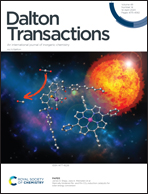Microwave-assisted synthesis followed by a reduction step: making persistent phosphors with a large storage capacity†
Abstract
The performance of impurity doped luminescent materials, or phosphors, depends on the composition and crystallinity of the host compound, as well as on the distribution and valence state of the dopant ions. This is particularly true for persistent phosphors, where both luminescence centers and charge trapping defects are required. Here we show that splitting the synthesis procedure in two separate steps offers a simple way to obtain efficient persistent phosphors which are superior to phosphors prepared via a conventional solid state synthesis using a single step. The storage capacity of the persistent phosphor benefits from using a microwave assisted solid state synthesis (MASS) to achieve superior compositional homogeneity, followed by a short heat treatment in a reducing atmosphere to reduce the activators. In this work, the approach is demonstrated for the efficient blue-emitting Eu2+,Dy3+ co-doped Sr2MgSi2O7 persistent phosphor. The enhanced ionic diffusion during the MASS not only improves the homogeneity and dopant distribution, but also allows the phosphor to be obtained in considerably shorter times (ca. 25 minutes). The storage capacity of the as-obtained phosphors prepared by MASS is slightly higher than those obtained by the conventional solid-state method. Cathodoluminescence (CL) measurements evidenced however the existence of a large fraction of unreduced europium activators. Using a short reducing step at 900 °C, the Eu3+ emission was almost fully suppressed in CL and as a consequence, the storage capacity of the MASS-obtained material showed a ten fold increase, confirming the benefit of decoupling compositional homogeneity and the dopant reduction step for phosphor synthesis.



 Please wait while we load your content...
Please wait while we load your content...